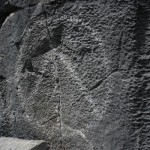
Marc Dadigan, Indian Country Today Media Network
This October, not far from Bishop, California five petroglyphs sacred to tribes in the area including the Paiute, Shoshone and Mono were stolen by vandals using chainsaws and ladders. Government officials compared the crime to cutting holes in the Wailing Wall.
On the other end of the state, about an hour from the Oregon border, the Winnemem Wintu’s sacred Eagle Rock, which is still a ceremonial place in use by the tribe, has long suffered desecrations by vandals carving initials into or spray-painting the rock.
Throughout the state, tribal leaders say sacred sites and burial sites are far too vulnerable to vandalism and destruction via development, and California State Assemblyman Mike Gatto (D-Los Angeles) agrees.
Gatto recently introduced a “placeholder” for Assembly Bill 52, which states his intent to enact legislation to improve the protection of sacred and cultural sites by requiring developers to consult with the appropriate tribes “prior to project initiation.”
“I think the state of California has not been great custodians of our history,” Gatto said. “After everything we’ve put our Native people through, it would be really wrong and a travesty if we allowed sacred sites to disappear.”
Gatto said he expects his office will spend the next two months consulting with tribes around the state, including federally unrecognized tribes, about what language would make the bill most effective.
He said the bill won’t have to be in final form until August, who added he thinks there is significant pressure to better protect sacred sites after the Bishop petroglyph incident.
Raymond Andrews, the Bishop Paiute Tribal Historic Preservation Officer, said he thinks it’s vital that tribes are brought to the table as a stakeholder at the very start of any development project.
“We told them we don’t just want to be asked to comment after they’ve drawn up all their plans and are already moving forward,” Andrews said. “We want to be right there when they’re planning these projects because they do affect us and our land, and we’re not going to change who we are.”
Gatto agreed that all too often tribes are only consulted well into the planning process when the development has gained significant momentum, which can make it a “fait accompli,” he said.
One possible solution, he said, might be to create a register of sacred sites, some of which would be private to protect the location of sensitive sites. Once a site was listed, it would have enhanced protections, and developers would be required to use the database to check for nearby sacred sites before they even begin planning a project, Gatto said.
“It would put everyone on notice well in advance that there are genuine sacred sites in the area,” Gatto said. “It would limit the criticism that people using laws to protect sacred sites are simply anti-development.”
One limitation of the bill is that it would only apply to state and local agencies, and, thus, would not apply to the many sacred sites located in land currently managed by federal agencies.
“The other stakeholders don’t know the tribes, they don’t know how to come in and be partners,” Andrews said. “They call us a stakeholder with the backpackers and horsemen, but our longevity and subsistence are tied to the land.”
People who are interested in providing input on the bill can contact Gatto’s legislative aide, Katerina Robinson at katerina.robinson@asm.ca.gov.